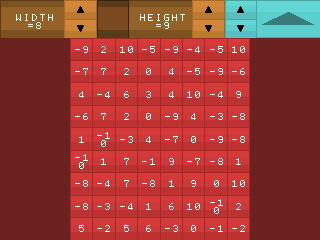Solve linear systems of equations and compute inverses, while also showing your work.
This is an upgrade of the famous
http://www.math.odu.edu/~bogacki/cgi-bin/lat.cgi?c=rref
It also contains some other extra programs, that I thought could be uploaded too as a bonus. So, enjoy.
This update uses artificial modulus and divide functions so that the overflow error doesn't happen, it now supports arbitrarily large dataset operations, as well as some other new features such as computing the determinant.
Instructions:
Use the circle pad, and other buttons including L and R to navigate.
Use the touch screen for everything else.
Say you want to solve:
1x + 3y - 2z = 5
3x + 5y + 6z = 7
2x + 4y + 3z = 8
You can use substitution and elimination like highschool teachers teach... or more elegantly input them into a matrix:
1 3 -2 5
3 5 6 7
2 4 3 8
And convert it to Reduced Row Echelon Form (RREF):
1 0 0 -15
0 1 0 8
0 0 1 2
And now you can see that:
x = -15
y = 8
z = 2
Let's test that these values are correct by plugging them in:
1(-15) + 3(8) - 2(2) = 5 True
3(-15) + 5(8) + 6(2) = 7 True
2(-15) + 4(8) + 3(2) = 8 True
Similarly, we can compute the inverse by concatenating an identity matrix to the end:
1 3 -2 1 0 0
3 5 6 0 1 0
2 4 3 0 0 1
Convert to RREF:
1 0 0 9/4 17/4 -7
0 1 0 -3/4 -7/4 3
0 0 1 -1/2 -1/2 1
And now the inverse is on the right side. Multiplying the original array by it's inverse will return an identity matrix, i.e.
1 0 0
0 1 0
0 0 1
Multiplying the inverse by the three output values: 5, 7, 8, will return the answers: -15, 8, 2.
If you need any homework help, comment below, and I may or may not help you :)



 Version:1.0Size:94.4KB
Version:1.0Size:94.4KB